| |
| ... |
|
|
|
|
|
| |
| May 31, 2005 |
|
Weekend 13 — Appendix
When collecting is real good, it's hard to capture all the data on a timely basis.Keith Robertson wrote in to note a few more relevant finds:
Squalodon incisors (with roots!) were found by Keith Robertson and Matt Howard. Matt also found a Squalodon molar.
Karissa Hendershot, Sophie Homsey, Keith Robertson and Matt Howard also found great whites (Carcharodon carcharias) — an unusually high number.
Mel Gulotta found a nearly complete Echinorhinus (prickly shark) tooth.
Sophie Homsey found two pearls, including one that was still attached to the oyster shell!
|
| May 29, 2005 |
|
Weekend 13 — A Glorious Finale
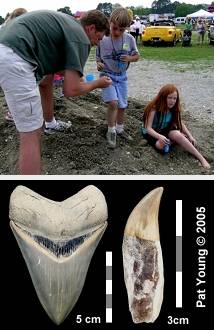 Pat Young reports: Today's seasoned collectors allowed no dust to settle beneath their feet as a slightly foggy and cool morning turned to a sunny 84 degrees. This final spring season group consisted of eager Aurora Fossil Festival (image) volunteers and staff from the NC State (Raleigh, NC) and Schiele Museums (Gastonia, NC). Knowing this area might not be available for collecting in the fall, prompted most to fill their bags and buckets to bulging. The long time Lee Creekers settled in for the 'meg' hunt. Uwe Heine certainly took top honors by finding the largest C. megalodons - two at 5-1/4 inches and another just 4-3/4". Joanne Dubrock found the smallest, a tiny 3/4 by 3/8 inch specimen. Others were found by David Wooten (4" upper anterior), Bruce Hargraves (4" lower anterior), Nancy Collins (3-7/8" - ref image), Gary Grimsley (3-1/2", 3", and 2-1/2"), Ken Young (3-1/4"), Richard Habron and Kerrie Green (3-1/8"). Smaller specimens, both megs and C. chubutensis were carried out by Trish Kohler, Glenn Bolick, John Miller, Bonnie Chaussee, Anne Lineberry and Mel Gulotta. Several large Cosmopolitodus hastalis (broad form) were seen with the largest being Melvie Hatfield's 2-7/8 inch specimen. Three Paroatodus benedini were found: Ron Edwards' black 2-3/4 incher, Dave Sanderson's (ref image) 2-1/2" blond example and another by Gary Grimsley with a damaged root. The only Hexanchus tooth I saw was Mike Keklak's lower, however two Notorynchus symphyseals left on the early bus. John Miller, Karissa Hendershot and Mike Keklak each found teeth in matrix. Several large Hemis were found as well as some nice G. cuvier teeth. Bob Asreen's 1-5/8" C. carcharias (image) and Eric Sadorf's pristine sun-bleached Carcharoides catticus shared top billing as the prettiest teeth of the day.
Pat Young reports: Today's seasoned collectors allowed no dust to settle beneath their feet as a slightly foggy and cool morning turned to a sunny 84 degrees. This final spring season group consisted of eager Aurora Fossil Festival (image) volunteers and staff from the NC State (Raleigh, NC) and Schiele Museums (Gastonia, NC). Knowing this area might not be available for collecting in the fall, prompted most to fill their bags and buckets to bulging. The long time Lee Creekers settled in for the 'meg' hunt. Uwe Heine certainly took top honors by finding the largest C. megalodons - two at 5-1/4 inches and another just 4-3/4". Joanne Dubrock found the smallest, a tiny 3/4 by 3/8 inch specimen. Others were found by David Wooten (4" upper anterior), Bruce Hargraves (4" lower anterior), Nancy Collins (3-7/8" - ref image), Gary Grimsley (3-1/2", 3", and 2-1/2"), Ken Young (3-1/4"), Richard Habron and Kerrie Green (3-1/8"). Smaller specimens, both megs and C. chubutensis were carried out by Trish Kohler, Glenn Bolick, John Miller, Bonnie Chaussee, Anne Lineberry and Mel Gulotta. Several large Cosmopolitodus hastalis (broad form) were seen with the largest being Melvie Hatfield's 2-7/8 inch specimen. Three Paroatodus benedini were found: Ron Edwards' black 2-3/4 incher, Dave Sanderson's (ref image) 2-1/2" blond example and another by Gary Grimsley with a damaged root. The only Hexanchus tooth I saw was Mike Keklak's lower, however two Notorynchus symphyseals left on the early bus. John Miller, Karissa Hendershot and Mike Keklak each found teeth in matrix. Several large Hemis were found as well as some nice G. cuvier teeth. Bob Asreen's 1-5/8" C. carcharias (image) and Eric Sadorf's pristine sun-bleached Carcharoides catticus shared top billing as the prettiest teeth of the day.

Marine mammal material was gathered by the bucketsful. Doug Chaussee brought out at least five associated whale vertebrae, two ear bones, and other parts. Lee Cone had eight propoise/dolphin verts. Paul Murdoch eagerly collected everything he could carry for upcoming fossil classes. Seal fossils have been scarce but today, Laura Aultman found a molar (image) with jawbone attached and Lee Cone (image) a nice canine tooth. Bonnie Chaussee had three associated dolphin teeth & a whale tooth, Mike Keklak two associated whale teeth and several others were also found. BJ Blake found what could only be described as an outstanding example of a 3-inch double batoid scute.
This season has been the best in years for PCS collectors. Having access to the pit and a wide variety of available sediments has made the collecting experience very exciting. We extend our thanks to PCS Phosphate, Aurora, NC, especially Curtis Ormond (Public Affairs and the Safety Department).
|
| May 16, 2005 |
|
Fossil Festival
The 12th annual Aurora Fossil Festival will kick off on Friday, May 27th at 6 pm. On Saturday, May 28, the fun will begin with a parade at 11am. Fossil displays will be held at the Community Center with representatives from the Smithsonian Institution available to help the public with fossil identification. The North Carolina State Museum will have it's huge Acrocanthosaurus skeleton for viewing. Organizations providing displays include the Schiele Museum, Calvert Marine Museum, National Aquarium (DC), Beaufort Maritime Museum and many others. A fossil auction, hosted by the Friends of the Museum, will be held at 3 pm at the Aurora Fossil Museum with proceeds to benefit the museum. Good food, music and entertainment will round out the days festivities. For further information, contact the Aurora Fossil Museum at 252-322-4238.
|
| May 21, 2005 |
|
Weekend 12 — And Still More
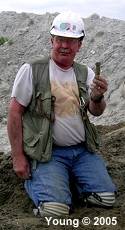 Pat Young reports: Saturday's group of 24 collectors were greeted with 50-degree, cloudy and windy conditions to start the morning. The sun waited to show itself until near noon. The one+ inch rains we had earlier in the week made for good finds but the generally muddy conditions made getting good images difficult. C. megalodon and chubutensis continued to show up, although not the giants of last week. The largest one I saw, a 5-1/2 inch reworked tooth missing a root lobe, was found by John Everette. Tom Arnold had fortune smile on him with a great 4-1/4 inch lower lateral Pungo tooth plus three other chubutensis -- all smaller but of equally good condition. Very nice megs or chubbies were also found by Billy Yates (3-3/4" & 1-3/8"), Dave Sanderson (3-1/4"), Katherine Sanderson (3"), Gene Barrett (2-3/4") and Don Clements (two posteriors-1-1/4" & a tiny blond beauty measuring 1 x 1/2"). Lots of others were found showing various levels of condition (dings, etc.). Large broad-form C. hastalis seemed particularly abundant, evidentially having been exposed by recent rains. Cuviers, hemis and sand tiger teeth were seen in every collection; Notorychus teeth were also in most bags. With the availability of large teeth on the surface, it seems no one is looking for brambles or threshers these days (none were reported).
Pat Young reports: Saturday's group of 24 collectors were greeted with 50-degree, cloudy and windy conditions to start the morning. The sun waited to show itself until near noon. The one+ inch rains we had earlier in the week made for good finds but the generally muddy conditions made getting good images difficult. C. megalodon and chubutensis continued to show up, although not the giants of last week. The largest one I saw, a 5-1/2 inch reworked tooth missing a root lobe, was found by John Everette. Tom Arnold had fortune smile on him with a great 4-1/4 inch lower lateral Pungo tooth plus three other chubutensis -- all smaller but of equally good condition. Very nice megs or chubbies were also found by Billy Yates (3-3/4" & 1-3/8"), Dave Sanderson (3-1/4"), Katherine Sanderson (3"), Gene Barrett (2-3/4") and Don Clements (two posteriors-1-1/4" & a tiny blond beauty measuring 1 x 1/2"). Lots of others were found showing various levels of condition (dings, etc.). Large broad-form C. hastalis seemed particularly abundant, evidentially having been exposed by recent rains. Cuviers, hemis and sand tiger teeth were seen in every collection; Notorychus teeth were also in most bags. With the availability of large teeth on the surface, it seems no one is looking for brambles or threshers these days (none were reported).
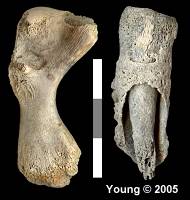 Large marine mammal vertebrae continue to be hauled out by collectors but few sperm whale or porpoise/dolphin teeth were seen. One complete Squalodon incisor and several molar tips were found. Ron (ref image) and Sharron continued excavation at the site of their fossil seal and finally came up with a tooth -- a rather badly worn incisor. Next Sunday, being the last day of spring season at PCS, will provide them with their last chance to add specimens to this outstanding discovery. I managed to find a nice turtle humerus (sp.?, image LH) and the claw core phalange (image RH) from a undetermined seal.
Large marine mammal vertebrae continue to be hauled out by collectors but few sperm whale or porpoise/dolphin teeth were seen. One complete Squalodon incisor and several molar tips were found. Ron (ref image) and Sharron continued excavation at the site of their fossil seal and finally came up with a tooth -- a rather badly worn incisor. Next Sunday, being the last day of spring season at PCS, will provide them with their last chance to add specimens to this outstanding discovery. I managed to find a nice turtle humerus (sp.?, image LH) and the claw core phalange (image RH) from a undetermined seal.
Invert fossils collected included: sand dollars (Mellita sp.) by Dave Sanderson & Glynda Barrett, a large keyhole limpet (Doidora pamlicoensis) by Ron Edwards, Charles Wells' cup and saucer shell (Crucibulum lawrencei) and Judy Stiles two Echinocardium kellogi.
|
| May 16, 2005 |
|
Fossil Festival
The 12th annual Aurora Fossil Festival will kick off on Friday, May 27th at 6 pm. On Saturday, May 28, the fun will begin with a parade at 11am. Fossil displays will be held at the Community Center with representatives from the Smithsonian Institution available to help the public with fossil identification. The North Carolina State Museum will have it's huge Acrocanthosaurus skeleton for viewing. Organizations providing displays include the Schiele Museum, Calvert Marine Museum, National Aquarium (DC), Beaufort Maritime Museum and many others. A fossil auction, hosted by the Friends of the Museum, will be held at 3 pm at the Aurora Fossil Museum with proceeds to benefit the museum. Good food, music and entertainment will round out the days festivities. For further information, contact the Aurora Fossil Museum at 252-322-4238.
|
| May 14-15, 2005 |
|
Weekend 11 — A Nineties Retro Weekend
Saturday's fossil collectors included a group of teachers from Wilmington, NC, employees of Progress Energy, NC and several non-club affiliated persons. The most relevant visitor however was Clyde Swindell, who stopped by to advise all that he had expanded the collecting area (all the way to the back of last season's tailings)! This announcement created lively morning chatter and renewed hopes of a fresh supply of shark teeth and bony fossils. We were not to be disappointed. The abundance of Yorktown and new Pungo tailings provided for collecting reminiscent of the "old days". The day's low-80's, sunny/cloudy skies and gentle breeze was just icing on the cake.
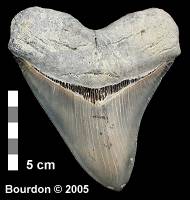 Pat Young reports: 'Megs' are the most sought after fossil at PCS and this day they surfaced in such abundance that a complete count was impossible, however, I'd estimate 40+ complete specimens. (One person was overheard to say he was running out of pockets for teeth.) Some of those who had found several were seen sharing megs with those who hadn't found any. Pungo teeth seemed to outnumber the Yorktown specimens but the quality of both was mostly good. Rita McDaniel managed to pick up the largest tooth of the day, a 6-1/8" one (perpendicular, not slant!). Although a root ear had been broken off, it fit back together nicely. Several teeth in the 5-inch range were also recovered. Judy Stiles' upper lateral (see image) measured in at 4-1/4" (4th largest of day). Kerrie Green's 3-1/2" Yorktown tooth was flawless. Allen Lightfoot showed off a sharp lower C. chubutensis (2-1/2"). Other nice meg/chubbie finds were made by Anna Clingenpeel, Zack Pringle, Mary Lightfoot (a great Yorktown posterior) and many more I failed to document. Cosmopolitodus hastalis (broad form) made a good showing with Tedo Kordela finding the biggest (2-7/8"). Trish Chasteen had a nice lower (2-1/8") and Chris Dutton a large lateral. Three Carcharodon carcharias were seen with the largest being 1-3/4". A single Isurus retroflexus was reported. Jim White's outstanding 2-1/2" Dasyatis scute featured three tips (see image).
Pat Young reports: 'Megs' are the most sought after fossil at PCS and this day they surfaced in such abundance that a complete count was impossible, however, I'd estimate 40+ complete specimens. (One person was overheard to say he was running out of pockets for teeth.) Some of those who had found several were seen sharing megs with those who hadn't found any. Pungo teeth seemed to outnumber the Yorktown specimens but the quality of both was mostly good. Rita McDaniel managed to pick up the largest tooth of the day, a 6-1/8" one (perpendicular, not slant!). Although a root ear had been broken off, it fit back together nicely. Several teeth in the 5-inch range were also recovered. Judy Stiles' upper lateral (see image) measured in at 4-1/4" (4th largest of day). Kerrie Green's 3-1/2" Yorktown tooth was flawless. Allen Lightfoot showed off a sharp lower C. chubutensis (2-1/2"). Other nice meg/chubbie finds were made by Anna Clingenpeel, Zack Pringle, Mary Lightfoot (a great Yorktown posterior) and many more I failed to document. Cosmopolitodus hastalis (broad form) made a good showing with Tedo Kordela finding the biggest (2-7/8"). Trish Chasteen had a nice lower (2-1/8") and Chris Dutton a large lateral. Three Carcharodon carcharias were seen with the largest being 1-3/4". A single Isurus retroflexus was reported. Jim White's outstanding 2-1/2" Dasyatis scute featured three tips (see image).
Marine mammal fossils, most headed for new homes in various elementary schools, were collected by the bucketsful. Betsy Bartlett's five fused sperm whale neck vertebra were especially nice. Sherri Dodson had an 8-inch whale vertebrae (plus others), Lou Brinkley a nice caudal vert, Cyd Phillips a 4-1/2" sperm whale tooth and Dorothie Johnson the only piece of shark cartilage seen recently.

The shell beds provided some excellent collecting opportunities and Jessica Croson managed to get both a sand dollar (Mellita sp.) and a sea urchin (Psammechinus philanthropus). Judy Stiles' Psammechinus (see image) measured 1-1/4 inches. Other nice finds of the day included a seal humerus & astragalus, partial porpoise jaw with two teeth, wahoo jaw with four teeth, several complete bird bones (including accompanying ?Alca femur, LH image) and Squalodon teeth (Sharron had four associated crowns alone).
At day's end, the show and tell session at the bus was as lively as the collecting had been and it took some coaxing from Becky to get us boarded for the trip back to the parking lot.
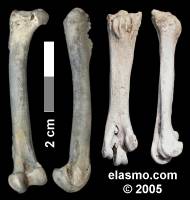 Sunday: Amid reports of Saturday's finds, the twenty Sunday collectors wasted no time in boarding the bus to the mine. Megs and chubbies were smaller and not as abundant, but nice finds were still made. Don Carr gathered the largest two specimens of the day-a huge mottled Pungo lower (5-1/2") and a 4-inch Yorktown upper. John Bullett's golden 3-inch chubbie with white root was especially beautiful. Smaller teeth, both megalodon and chubutensis, were found by Pat Hammond, Uwe Heine, John Everette, Brian Koger, Carol Veigle and others. Large hastalis continued showing up with Brian Koger's last find of the day, a 2-inch shiny black lower, being especially nice. Kirk Talbert and Brian Rountree each found Carcharodon carcharias teeth; Kirk also reported an Isurus retroflexus. A closer to the ground collecting method yielded some very large Hemipristis and many more G. cuvier than were collected on Saturday. Becky Hyne had a small posterior Carcharoides catticus tooth.
Sunday: Amid reports of Saturday's finds, the twenty Sunday collectors wasted no time in boarding the bus to the mine. Megs and chubbies were smaller and not as abundant, but nice finds were still made. Don Carr gathered the largest two specimens of the day-a huge mottled Pungo lower (5-1/2") and a 4-inch Yorktown upper. John Bullett's golden 3-inch chubbie with white root was especially beautiful. Smaller teeth, both megalodon and chubutensis, were found by Pat Hammond, Uwe Heine, John Everette, Brian Koger, Carol Veigle and others. Large hastalis continued showing up with Brian Koger's last find of the day, a 2-inch shiny black lower, being especially nice. Kirk Talbert and Brian Rountree each found Carcharodon carcharias teeth; Kirk also reported an Isurus retroflexus. A closer to the ground collecting method yielded some very large Hemipristis and many more G. cuvier than were collected on Saturday. Becky Hyne had a small posterior Carcharoides catticus tooth.
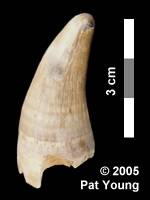 Other interesting finds included Liz Allyn's duck (cf Histrionicus, see image, RH) leg (tarsometatarsus) bone, Donnie Stroud's two associated whale bullas, Jennifer Stroud's pristine tulip shell (Fasciolaria beaufortensis), Kim Greene's five associated sperm whale teeth, Ron Edward's crocodile tooth (1-3/4", see image),and several nice echinoids. Whale vertebrae continued to be abundant.
Other interesting finds included Liz Allyn's duck (cf Histrionicus, see image, RH) leg (tarsometatarsus) bone, Donnie Stroud's two associated whale bullas, Jennifer Stroud's pristine tulip shell (Fasciolaria beaufortensis), Kim Greene's five associated sperm whale teeth, Ron Edward's crocodile tooth (1-3/4", see image),and several nice echinoids. Whale vertebrae continued to be abundant.
Gregg Walden found an unusual bone, later determined to be from a modern pork chop and declared by Sharron Edwards to originate from the Porktown Fm. Collectors are urged to assist PCS in their award winning reclamation program by not leaving refuse behind. Another problem that continues is collectors not showing up for their assigned dates. If you will not be able to commit to your reservation, please cancel so that others may use your slots.
|
| May 12, 2005 |
|
Otodus Dentition
I finally added an Otodus tooth-set on the Otodus page. This should prove helpful when comparing it to that on the new Carcharocles page. With that said, the Carcharocles page has had a few tweaks based on reader input/confusion. A few more clarifications seem to be needed, so additional text should appear in the near future. This weekend's news will be a couple day's late, I'm goin' fishin".
|
| May 7, 2005 |
|
Weekend 10 — Tailings for the Birds
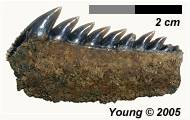 Pat Young reports: Friday's 5+ inches of rain assaulting the hills of PCS in 50+ mph gusts should have provided the very best in fossil collecting for members of the Tampa Bay Fossil Club, Educators of Excellence Fossil Club (Garner, NC) and a group of teachers from Myrtle Beach, SC (lead by Tom Rex - principal). Newly exposed fossils were generally in very good condition, but the abundance of larger teeth left something to be desired. Megs were scarce with Candace Holliday bringing in the largest one, a 2-1/2" black lower tooth with root damage. Other megs were smaller: Ken Young (2"), Jerry Zolg (2 & 1-1/4") and an interesting 2-inch pathological found by Eric Sadorf. C. hastalis teeth were much more plentiful with nice large specimens (some in excess of 2") being collected by most of those crawling the Yorktown sands. Norbert Dunkel found a complete 1-1/2" Hexanchus lower (ref image) and Frank Ullmayer a partial. Joanne Ullmayer found a 1-1/4" Parotodus benedini. Quite a few Notorynchus teeth were also seen, but John Than's large upper was particularly pretty. Candace had a pathologic bramble tooth which unfortunately was missing a cusp. Other finds were the usual Hemis, contortus and Carcharhinus species.
Pat Young reports: Friday's 5+ inches of rain assaulting the hills of PCS in 50+ mph gusts should have provided the very best in fossil collecting for members of the Tampa Bay Fossil Club, Educators of Excellence Fossil Club (Garner, NC) and a group of teachers from Myrtle Beach, SC (lead by Tom Rex - principal). Newly exposed fossils were generally in very good condition, but the abundance of larger teeth left something to be desired. Megs were scarce with Candace Holliday bringing in the largest one, a 2-1/2" black lower tooth with root damage. Other megs were smaller: Ken Young (2"), Jerry Zolg (2 & 1-1/4") and an interesting 2-inch pathological found by Eric Sadorf. C. hastalis teeth were much more plentiful with nice large specimens (some in excess of 2") being collected by most of those crawling the Yorktown sands. Norbert Dunkel found a complete 1-1/2" Hexanchus lower (ref image) and Frank Ullmayer a partial. Joanne Ullmayer found a 1-1/4" Parotodus benedini. Quite a few Notorynchus teeth were also seen, but John Than's large upper was particularly pretty. Candace had a pathologic bramble tooth which unfortunately was missing a cusp. Other finds were the usual Hemis, contortus and Carcharhinus species.
Most of the bony fish fossils, not having been previously exposed, were found in very good condition, The replenished stocks of marine mammal fossils were eagerly gathered by those seeking classroom supplies. Intensive digging paid off for Rob Carlson in the form of a huge whale vertebra and skull elements. Taking a rest in Yorktown soils paid off for me today in the form of seven associated whale teeth. Ron and Sharron continued their excavation at the site of last week's seal find and recovered even more bones. Teeth from this site have not been found yet; most of the recovered items appear to be posterior parts. The area is still flagged for protection.

It appeared that today's collectors avoided the James City exposures as few inverts were seen (a sand dollar or two should show in next weeks fossil bags). While searching the 'washer pits' for Squalodon teeth, BJ Blake stumbled across the above killdeer guarding her nest. The various species of clam shells made a perfect nest for a clutch of three eggs.
|
| May 6, 2005 |
|
Correction
In last weekend's news, we incorrectly ascribed Matt Howard's C. chubutensis teeth to Yorktown Unit 1, they were infact found in Pungo River sands. The news item has been corrected.
|
| May 2, 2005 |
|
Carcharocles Genus Page
Some nine-months in the making, elasmo.com finally has its own Carcharocles page. We hope it will prove insightful & useful.
|
| May 1, 2005 |
|
Weekend 9 Sunday — Still Blowin'
 Pat Young reports: Gathering in a drenching rain and high winds (again), 40 members of the Suanee Creek Fossil Club, American Fossil Federation, Florida Fossil Hunters, JHU-APL Fossil Club and a group of collectors from Ashville, NC struggled to fill out wet papers in advance of going into the mine. How this group managed to handle the necessary aggra- vations with such obvious gaiety is beyond belief. Arrival at the pit saw the demise of the rain but even fiercer winds. The sun finally revealed itself at 9:45 but remained intermittent most of this cool (c65-degree) day.
Pat Young reports: Gathering in a drenching rain and high winds (again), 40 members of the Suanee Creek Fossil Club, American Fossil Federation, Florida Fossil Hunters, JHU-APL Fossil Club and a group of collectors from Ashville, NC struggled to fill out wet papers in advance of going into the mine. How this group managed to handle the necessary aggra- vations with such obvious gaiety is beyond belief. Arrival at the pit saw the demise of the rain but even fiercer winds. The sun finally revealed itself at 9:45 but remained intermittent most of this cool (c65-degree) day.
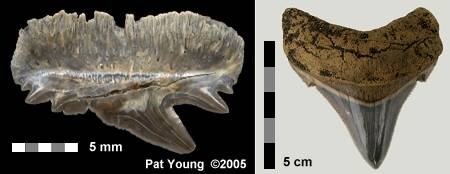
Shark teeth of any sort are getting scarce but a few outstanding finds were made today. Matt Howard found two beautiful C. chubutensis-design teeth (2-1/2", ref image & 1-1/2") within inches of each other in a section of Pungo River sand. Montine Heim picked up a 2-1/2 incher and two posteriors while Marco Gulotta got a 2-1/4 incher. Large C. hastalis (broad form) was best represented by Zandra Elder's great lower (2-1/2") but others of equal size were found by Ross Rottier, Jon Erikson and Marco Gulotta, Jr. Several large narrow form hastalis were seen as well. Melvin Gulotta had a decent 2-inch C. carcharias tooth. E. blakei teeth were collected by Bill Heim and John Everette who got a lateral and a ?pathological (ref image). Passing the book around the bus revealed a few more fossils --- Sarah Graham got a whale tooth and Dominic Joos collected 30 coffee beans (Trivia floridana). Marco Gulotta reported four Notorynchus lowers and Montine Heim, two. Two 5-gallon buckets of coral were seen leaving. Thanks, guys!
It's obvious that rain is getting to be a more important factor in balancing the collecting stress with the refreshment rate. The Pungo crawl is being seen more often and rakes are coming in handy for more than just walking sticks these days.
|
| April 30, 2005 |
|
Weekend 9 Saturday — What's With This Weather
Pat Young reports: Although forecasts of imminent stormy weather threatened the day, 36 members of the Dahlgren Fossil Club, East Coast Fossil Club and Delaware Mineralogical Society met at the parking lot for a fun-filled day of fossil hunting. The strong winds and blowing sands of our "Mecca" hindered collecting a bit, but good humor carried the day.
 Of the three megs found, Jerry Britt's was the largest -- a three inch Pungo specimen; Candace Holliday and Becky Hyne each had smaller ones. Broad form Cosmopolitodus hastalis, while not plentiful, were represented by some nice teeth. Glenn Branch, George Powell, Keith Robertson, and Candace found large ones, while Fred Hendershot managed two juveniles. Scott Peters, Fred Hendershot, Eric Sadorf and Becky managed to take home pretty Squatina teeth. Becky also found an E. blakei posterior. Notorynchus lowers were found by Blair Venables (4), Bob Asreen (3), Scott Peters, Amanda Cone, Andy Albright and Anne Lineberry. Dana McGuirt and Karissa Hendershot each found Hexanchus lowers. A 1-5/8' Hemi and 1-1/2" Odontaspis ferox anterior (see image) accompanied Marge Noel home.
Of the three megs found, Jerry Britt's was the largest -- a three inch Pungo specimen; Candace Holliday and Becky Hyne each had smaller ones. Broad form Cosmopolitodus hastalis, while not plentiful, were represented by some nice teeth. Glenn Branch, George Powell, Keith Robertson, and Candace found large ones, while Fred Hendershot managed two juveniles. Scott Peters, Fred Hendershot, Eric Sadorf and Becky managed to take home pretty Squatina teeth. Becky also found an E. blakei posterior. Notorynchus lowers were found by Blair Venables (4), Bob Asreen (3), Scott Peters, Amanda Cone, Andy Albright and Anne Lineberry. Dana McGuirt and Karissa Hendershot each found Hexanchus lowers. A 1-5/8' Hemi and 1-1/2" Odontaspis ferox anterior (see image) accompanied Marge Noel home.
For some, mammal material was the fare of this day. Lee Cone and Gregg Walden each got Squalodon molars and one incisor was also seen. Sperm whale teeth included those of Tony DeMonti, Karissa Hendershot and Candace Holliday (2). Dana McGuirt brought out a nice seal metatarsal while BJ Blake got a metacarpal. Hunkering down to avoid the wind, paid well for Ron Edwards. Not wanting to waste time, he used his shovel to work on a small patch of Yorktown and began bringing up seal bones, including caudal verts, phalanges, knuckles, ribs and other parts (many too covered with dirt to identify). By day's end he had accumulated over 40 pieces. The site is now flagged to allow him to finish the recovery.
A very nice anterior upper pharyngeal, of a yet to be identified fish, was recovered by Scott Peters and Rita McDaniel brought out a huge horse conch.
|
| April 23, 2005 |
|
Weekend 8 — Hail & Limestone
Pat Young reports: Although threats of extreme weather kept some at home, twenty-three die-hard fossil fans, including members of the Eastern Missouri Society for Paleontology and the Gem and Mineral Society of the Virginia Peninsula decided to take their chances. A balmy 70-degrees with light breezes heightened hopes for a productive day of collecting. There had been no rain this week, so we were forced to follow the footsteps left by the previous Sunday's group and use the nose-to-the-ground technique.
Jim White managed the largest C. megalodon, a 3-3/4 inch black Pungo upper (located under a bush) in surprisingly sharp condition. He used the 'rock-roller' method to recover a nice 3-1/4" Yorktown upper. Mark Scott found a beautiful Yorktown 2-1/4" upper (ref. image) and also a smaller one. A nice 2-inch lower was found by Bob Englebretson. Cosmopolitodus hastalis (broad-form) teeth were mostly small, but Rich Olsen's upper lateral measured two inches. Notorynchus teeth continue to surface, evidentially being uncovered by wind; Brian Burdette got a very nice black symphyseal. Other finds were the usual P. contortus, G. cuvier, and carcharhinids (Hemipristis teeth seem to be getting scarce).
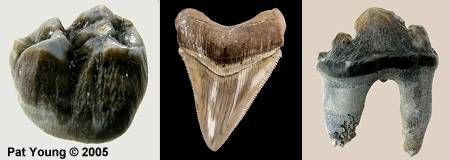
Most of the better quality mammal fossils are gone, however, Keith Robertson and Paul Chamberlain each found large (4+ inch) sperm whale teeth, and I saw several smaller ones. Nando Musmarra found a whale bulla and tooth which he believes are 'associated'. He also added an associated set of hake dentaries to his collection. No one has mastered the nose-to-the-ground technique better than Ron and Sharron Edwards. This day Ron managed to find a peccary tooth (?deciduous, the first of the season and never common, 1/2 inch wide, ref. image) and Sharron, a perfect seal molar (1/2 inch high, ref. image); Keith Robertson also found a slightly damaged one. Invert material was tied (in the interest category) by Eric Sadorf's 7 mm fossil pearl and Diana Fattori's pathologic Trivia shell. Jim White found yet another fossilized fish skull (3 cm.), this one appears complete and may hold otoliths.
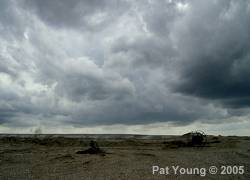 Rapidly approaching storm clouds prompted Becky to cut the day short by 1/2 hour, and not a moment too soon. Immediately after reaching the parking lot, the first bolt of lightening flashed. The brief hailstorm that followed produced a barrage of small ice balls. For those of us still wearing our hard hats, the pinging sound of ice bouncing off our heads was quite exciting. I doubt it was as much fun for those who had removed their hats. Torrential rains followed which sent all of us scurrying to our cars and going our separate ways without proper good-byes.
Rapidly approaching storm clouds prompted Becky to cut the day short by 1/2 hour, and not a moment too soon. Immediately after reaching the parking lot, the first bolt of lightening flashed. The brief hailstorm that followed produced a barrage of small ice balls. For those of us still wearing our hard hats, the pinging sound of ice bouncing off our heads was quite exciting. I doubt it was as much fun for those who had removed their hats. Torrential rains followed which sent all of us scurrying to our cars and going our separate ways without proper good-byes.
|
| April 17, 2005 |
|
Weekend 7 - Sunday: — Diligence and Luck
Pat Young reports: Sunday's frosty Spring morning warmed quickly to more seasonal temperatures (high 60's) and provided a very pleasant collecting experience for forty-one members of the Calvert Marine Fossil Club, Delaware Valley Paleontology Society, Cape Fear Mineral and Gem Club and a paleo-oriented group from North Carolina State University-Raleigh.

Although Sundays are noted for not being particularly productive collecting days, today's group proved that diligence pays well. Mike Reese found the largest Carcharocles megalodon tooth, a beautiful 3-5/8 inch upper anterior from the Yorktown. Mike Keklak followed his lead, bringing in a 3-inch lower. Equally nice smaller ones were found by Tom McKeeman and Joyce Isaza. Richard Habron had the largest C. chubutensis at 2-3/4 inches with George Powell and Henry Hayes finding smaller ones. Tim Collier found the only Carcharodon carcharias of the day, a lower anterior. Unusual tooth finds included Richard Habron's Alopias grandis (ref. image) and pathologic teeth found by Henry Hayes (abnormal growth on crown) & John Everette (carcharhinid with a split tip). An outstanding cookiecutter (Isistius cf triangulus), the first since the pit re-opened to collectors, was finally recovered (ref. image). Other shark teeth, including Notorynchus, were plentiful.
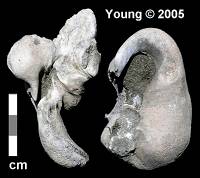 Mammal material made an extremely good comeback. Tom McKeeman found a 3-1/2 " sperm whale tooth and Cathy Young, two associated smaller ones. Other specimens were found by John Keklak, Joyce Isaza, Greg Auriemma, Marc Griffin and Richard Habron. Diana Fattori found an unusual ?dolphin tooth (ref. Image). First-timer Mary Schweitzer brought out a beautiful Squalodon atlanticus molar and Steve Ballwanz & Richard Habron incisors. Joyce Isaza had a Pilot whale tooth in perfect condition. Tom Bush came away with a nice whale bulla and Ron Edwards, an associated bulla and periotic (ref. image). Stephen Godfrey found a pathologic whale atlas vertebra (Baleenoptera sp.). He also recovered a shark-bitten rib bone that had a partial tooth still imbedded within it.
Mammal material made an extremely good comeback. Tom McKeeman found a 3-1/2 " sperm whale tooth and Cathy Young, two associated smaller ones. Other specimens were found by John Keklak, Joyce Isaza, Greg Auriemma, Marc Griffin and Richard Habron. Diana Fattori found an unusual ?dolphin tooth (ref. Image). First-timer Mary Schweitzer brought out a beautiful Squalodon atlanticus molar and Steve Ballwanz & Richard Habron incisors. Joyce Isaza had a Pilot whale tooth in perfect condition. Tom Bush came away with a nice whale bulla and Ron Edwards, an associated bulla and periotic (ref. image). Stephen Godfrey found a pathologic whale atlas vertebra (Baleenoptera sp.). He also recovered a shark-bitten rib bone that had a partial tooth still imbedded within it.
It's particularly fun to write this report when the weather, visitors and results all cooperate — it's great when it all comes together.
|
| April 16, 2005 |
|
Weekend 7 - Saturday: — Blow me down
The week's nor'easter continued to blow through Saturday, but spared the day's collectors the rain. The day began in the low-40s, only reaching 50 by early afternoon. The windy conditions little affected the forty-five visitors from the New Jersey Paleo Society, Delaware Valley Paleo Society, Maryland Natural History Society and Hampton Virginia Science Teachers. Despite the week's rain, most visitors entered with tempered expectations, probably explaining the general humor encountered throughout the day.

A couple of the larger megs, elusive so far this month finally appeared. Howie Cohn found a 4-1/4-inch lower anterior peaking out from some James City-covered Yorktown. A few members held their collective breath as it was slowly exposed and proved complete (ref image). George Oliver found a 3-3/8" upper lateral and Jim White a 2-1/2" lower anterior; others were much smaller. Cosmopolitodus teeth were small (less than 1-3/4") and not abundant. The James City continues to offer-up modern Great white shark teeth -- this day's were to Kathleen Harrison (1-3/4") and Josh King (1-5/8"). Notorynchus continues to be well represented (dozen or so), including Candace's pretty little symphyseal. Jim ?Forrest opened his snuff box to reveal a beautiful Odontaspis ferox anterior with spectacular cusplets. Becky had what is one of those rare Lee Creek finds, a Pristis rostral tooth. Otherwise, most collectors seemed to leave with a good selection from the requlars: Hemipristis, Charcharinus, Galeocerdo, Physogaleus, Sphyrna and Alopias.
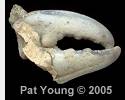 Mammal material seems to have dropped-off. There was a variety but not abundance of sperm whale and dolphin/porpoise teeth, but no Squalodon and a single seal (Pat Young) tooth. Don Resciniti carried out an associated set of whale vertebra (ref image). Fish material was spotty, but included Howie Cohn's group of ?associated sturgeon scutes, Kim Greene's Red drum premax and Roberta Dann's partial Black drum pharyngeal. A single Yorktown exposure was finally found that yielded otoliths, but not in the abundance of previous years. Lastly, Becky found a nice little xanthid (mud crab) claw (ref image).
Mammal material seems to have dropped-off. There was a variety but not abundance of sperm whale and dolphin/porpoise teeth, but no Squalodon and a single seal (Pat Young) tooth. Don Resciniti carried out an associated set of whale vertebra (ref image). Fish material was spotty, but included Howie Cohn's group of ?associated sturgeon scutes, Kim Greene's Red drum premax and Roberta Dann's partial Black drum pharyngeal. A single Yorktown exposure was finally found that yielded otoliths, but not in the abundance of previous years. Lastly, Becky found a nice little xanthid (mud crab) claw (ref image).
Most collectors said they enjoyed the day, despite the 'blow me down', hardhat chasing winds. Guess it's good to see expectations reaching equilibrium with reality.
|
| April 9, 2005 |
|
Weekend 6: — Collecting without excuses
Pat Young reports: Saturday's brisk NE winds, misting rain and 58 degree temps greeted 36 members of the Maryland Geological Society, Southwest Florida Fossil Club, Michigan Museum of Paleontology, Tampa Bay Fossil Club and several non-club affiliated collectors at PCS. No new area had been opened to collecting but the previous week's 3/4-inch of rain held promise.
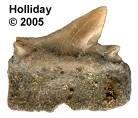 Large specimens of C. megalodon have been elusive in these mostly James City/Croatan sediments, and today was no exception. The largest one I saw was Steve Wilson's three-inch Pungo specimen; he also found a 2-1/2 incher. Others in the 2-1/2 inch range were the beautiful Yorktown of Melvie Hatfield and Brady Hamilton. Several small C. chubutensis were also found. Today's 'teeth of interest' were the fine Parotodus benedini found by Roxane Wilson (1-5/8") and Ron Edwards (1-1/2"). Candace Holliday followed with a perfect blond posterior Echinorhinus blakei tooth (ref. image). Cosmopolitodus hastalis teeth surfaced with more than customary abundance (probably due to wind and rain) and some great teeth were found; BJ BLake found the largest -- a 2-1/2" lower. Galeocerdo cuvier teeth seemed to surface in greater quantities than earlier in the season -- everybody I talked with had a least one. Brady Hamilton found a nice re-worked tooth in the Yorktown which we think may be Alopias grandis but he will seek further confirmation of that ID. Other finds were the usual P. contortus, G. aduncus, H. serra and some very nice Carcharias teeth. Notorynchus uppers and lowers were found by Carol Homon, Dave Blondin, Roxane Wilson, Candace Holliday, and Melvie Hatfield. John Everette, seen scouting the upper shell beds again, managed to recover a Squatina tooth.
Large specimens of C. megalodon have been elusive in these mostly James City/Croatan sediments, and today was no exception. The largest one I saw was Steve Wilson's three-inch Pungo specimen; he also found a 2-1/2 incher. Others in the 2-1/2 inch range were the beautiful Yorktown of Melvie Hatfield and Brady Hamilton. Several small C. chubutensis were also found. Today's 'teeth of interest' were the fine Parotodus benedini found by Roxane Wilson (1-5/8") and Ron Edwards (1-1/2"). Candace Holliday followed with a perfect blond posterior Echinorhinus blakei tooth (ref. image). Cosmopolitodus hastalis teeth surfaced with more than customary abundance (probably due to wind and rain) and some great teeth were found; BJ BLake found the largest -- a 2-1/2" lower. Galeocerdo cuvier teeth seemed to surface in greater quantities than earlier in the season -- everybody I talked with had a least one. Brady Hamilton found a nice re-worked tooth in the Yorktown which we think may be Alopias grandis but he will seek further confirmation of that ID. Other finds were the usual P. contortus, G. aduncus, H. serra and some very nice Carcharias teeth. Notorynchus uppers and lowers were found by Carol Homon, Dave Blondin, Roxane Wilson, Candace Holliday, and Melvie Hatfield. John Everette, seen scouting the upper shell beds again, managed to recover a Squatina tooth.
Mammal material fared well with Chris Hurd finding a 3-inch Squalodon canine tooth and a cetacean bulla. Tom Field recovered a great porpoise/dolphin ulna and BJ a large & a small humerus. Judy Stiles collected a humerus and a seal astragulus. Sally Labadie's best find of the day was a partial wahoo jaw. The invert find of the day was surely BJ Blake's stone crab claw. By returning late to the bus today, I'm sure I missed some other nice specimens.
|
| April 3, 2005 |
|
Sunday — The winds commeth
Pat Young reports: Sunday would be a unique day for Lee Creek -- two buses. The combined collecting day would include many visitors: NC Sate Museum, Catawba Valley Fossil Club, NC Shell Club, Georgia Assoc. of Marine Educators, Tarheel Gem and Mineral, NC Maritime Museum, National Aquarium (DC) and Richmond Gem and Mineral Society. Sunday's winds proved as ferocious as Saturday's rain. Although we enjoyed a pleasantly high temperature of 64 degrees, the 50 mph bursts provided a challenge. Fossil collectors needed to stay low to the ground, and the day's bounty was a reflection of that action.
 Carcharocles megalodon teeth were not particularly abundant, but included those by Jim White (2-1/2" lower), Susan O'Connor (2-1/4"), Rich Johnson (2" lateral), Kim Greene (1-1/4" posterior), Sharron Edwards (2-5/8") and Judy Stiles' 2-1/4-inch pathologic. Becky Hyne found a tiny (1-inch) posterior C. chubutensis which she traded to Shelda Aultman for a pair of knee pads (Echinorhinus bound?). The James City sands yielded four Carcharodon carcharias teeth; Rich Johnson, Anne Lineberry, Amanda Cone and Jeff Wiblitzhouser each found nice specimens in the 1-5/8" range. Saturday's rain exposed numerous and some very pretty Cosmopolitodus hastalis teeth, the largest being the 2-1/4" uppers of Anne Lineberry & Dave Sanderson and a 2-incher by Baxter Leonard. The largest lower was Elizabeth Simmons' 2-1/4" tooth; Bonney Weathers and Rich Johnson each found 2-inchers. Many smaller cosmo teeth were also collected. Surprisingly, few collectors found Notorynchus teeth, although Keith Robertson picked seven lowers and Becky, three uppers. The second Parotodus benedeni tooth (1-5/8") of the season was found by Joe Morgan. If one collected the Pungo limestones, small shark, barracuda and dolphin teeth were exposed with every gust. Gregg Walden (a confirmed Pungo-phile) found a nice pathologic dolphin tooth (ref. image) and Ken Young brought out two Squatinas.
Carcharocles megalodon teeth were not particularly abundant, but included those by Jim White (2-1/2" lower), Susan O'Connor (2-1/4"), Rich Johnson (2" lateral), Kim Greene (1-1/4" posterior), Sharron Edwards (2-5/8") and Judy Stiles' 2-1/4-inch pathologic. Becky Hyne found a tiny (1-inch) posterior C. chubutensis which she traded to Shelda Aultman for a pair of knee pads (Echinorhinus bound?). The James City sands yielded four Carcharodon carcharias teeth; Rich Johnson, Anne Lineberry, Amanda Cone and Jeff Wiblitzhouser each found nice specimens in the 1-5/8" range. Saturday's rain exposed numerous and some very pretty Cosmopolitodus hastalis teeth, the largest being the 2-1/4" uppers of Anne Lineberry & Dave Sanderson and a 2-incher by Baxter Leonard. The largest lower was Elizabeth Simmons' 2-1/4" tooth; Bonney Weathers and Rich Johnson each found 2-inchers. Many smaller cosmo teeth were also collected. Surprisingly, few collectors found Notorynchus teeth, although Keith Robertson picked seven lowers and Becky, three uppers. The second Parotodus benedeni tooth (1-5/8") of the season was found by Joe Morgan. If one collected the Pungo limestones, small shark, barracuda and dolphin teeth were exposed with every gust. Gregg Walden (a confirmed Pungo-phile) found a nice pathologic dolphin tooth (ref. image) and Ken Young brought out two Squatinas.
Mammal material, although not abundant, was represented by a few fine specimens. Dave Sanderson and Becky found great Squalodon atlanticus premolars and Richey Havens and BJ Blake seal metacarpals. Sperm whale teeth were had by Carl Miller (4"), Bonney Weathers (3") and smaller ones by Brandis Hartsell, Debbie Wyatt & Jeff Wiblitzhouser. Baxter Leonard brought out an outstanding Pungo whale humerus, BJ two very nice periotics and others a few previously unexposed vertebrae. Donna Snead found a very nice tulip shell.
|
| April 2, 2005 |
|
Saturday — Heavenly tears trump
 Pat Young reports: Fossil collectors, like fishermen, are a diverse group which might superficially appear to have little in common. Saturday's attempts at collecting PCS proved that image a myth. Teachers, gutter cleaners, doctors, carpenters, judges and others gathered in a quickly flooding PCS parking lot. The weather forecast of rain clearing by late morning gave all the hope of finding newly exposed specimens. After all, if one is already wet, might as well collect. With Candace at the wheel, the bus managed to make it to the pit area and unload the first group. Mother Nature immediately sent a signal, in the form of a lightning bolt, that there would be no collecting this day.
Pat Young reports: Fossil collectors, like fishermen, are a diverse group which might superficially appear to have little in common. Saturday's attempts at collecting PCS proved that image a myth. Teachers, gutter cleaners, doctors, carpenters, judges and others gathered in a quickly flooding PCS parking lot. The weather forecast of rain clearing by late morning gave all the hope of finding newly exposed specimens. After all, if one is already wet, might as well collect. With Candace at the wheel, the bus managed to make it to the pit area and unload the first group. Mother Nature immediately sent a signal, in the form of a lightning bolt, that there would be no collecting this day.
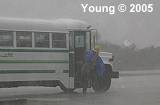 The second group of collectors (with crossed fingers) impatiently waited in the parking lot, expecting an empty bus would return to carry them in also (most claimed not to have seen the lightning or heard the thunder). The sight of a returning bus, loaded with people, told a sadly different story. Today's collectors were invited to collect on Sunday -- few refused the offer. After all, 1-3/4 inches of rain in two hours is a fossil collector's dream.
The second group of collectors (with crossed fingers) impatiently waited in the parking lot, expecting an empty bus would return to carry them in also (most claimed not to have seen the lightning or heard the thunder). The sight of a returning bus, loaded with people, told a sadly different story. Today's collectors were invited to collect on Sunday -- few refused the offer. After all, 1-3/4 inches of rain in two hours is a fossil collector's dream.
A serious 'fossil fever' and no collecting opportunity caused most of us to retreat to the Aurora Fossil Museum, where Harry Douglas, museum assistant, welcomed our wet, bedraggled group with open arms. After touring the museum and enjoying an extensive social hour, collectors dispersed to the museum 'reject piles' and various roadside locations in hopes of finding those ever elusive Carcharoides catticus and Squalodon atlanticus teeth.
|
| March 26 & 27, 2005 |
|
Weekend 4: É Sempre Pasqua ad Aurora
Pat Young reports: The hills to the east have been teasing collectors all season. Saturday, forty-five members from the North Carolina Fossil Club were met with some good news; they would be the first to sample this bounty. It was immediately apparent that this was Yorktown at its best -- bones and teeth were literally everywhere.
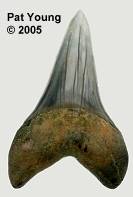 Reports of Carcharocles megalodon teeth being found came in faster than they could be documented. Earl Guertin managed to find the largest, a perfect 4-1/2" upper (3rd). Other smaller ones were found by Richard Chandler, John Belfiore, Ruffin Tucker, Gregg Walden (3), Kim Greene (2), Becky Hyne (2), Ron Edwards (3) and John Everette. Cosmopolitodus hastalis were best represented by John Belfiore's 2-1/2" upper and Eric Sadorf's 2-3/4" lower (ref. image). Smaller specimens were abundant. Dennis Hess found a large Parotodus benedeni (missing a root lobe), while Heather Power brought out a 2-5/8" Carcharodon carcharias. and Ken Young a black Echinorhinus tooth. Notorynchus lowers were found by Rick Bennett, Joanne Dubrock, Kim Greene, Tim Bennett and Xan Dubrock Several uppers were also found, and Becky picked a very nice lower symphyseal. Other teeth, less showy, were abundant.
Reports of Carcharocles megalodon teeth being found came in faster than they could be documented. Earl Guertin managed to find the largest, a perfect 4-1/2" upper (3rd). Other smaller ones were found by Richard Chandler, John Belfiore, Ruffin Tucker, Gregg Walden (3), Kim Greene (2), Becky Hyne (2), Ron Edwards (3) and John Everette. Cosmopolitodus hastalis were best represented by John Belfiore's 2-1/2" upper and Eric Sadorf's 2-3/4" lower (ref. image). Smaller specimens were abundant. Dennis Hess found a large Parotodus benedeni (missing a root lobe), while Heather Power brought out a 2-5/8" Carcharodon carcharias. and Ken Young a black Echinorhinus tooth. Notorynchus lowers were found by Rick Bennett, Joanne Dubrock, Kim Greene, Tim Bennett and Xan Dubrock Several uppers were also found, and Becky picked a very nice lower symphyseal. Other teeth, less showy, were abundant.
 The smaller Pungo areas yielded some of the finest Squalodon atlanticus teeth seen in quite a while. Top quality specimens were found by Becky (incisor & molar), Gregg Walden (2 incisors), Dennis Hess (incisor & molar), John Everette (incisor), Ken Young (molar), myself (premolar, ref. image) and several other incomplete ones. Rick Bennett and Ron Edwards each found associated sperm whale teeth (two five-inchers each) with Dave Brown, Val Kreil, Tim Bennett and Carl Willis also taking home several each. Nice dolphin and porpoise teeth were very common this day. Todd Power found the largest barracuda tooth ever seen here -- a 1-1/2" palatine tooth. Other finds included: Xan Dubrock's billfish rostrum (?Hemirhabdorhynchus sp), Eric Sadorf's rose-colored Astroscopus otolith (Stargazer, ref image) and Carl Willis' two ray scutes & Pagrus hyneus (porgy) skull specimen. Jo Belfiore and John Everette each found complete porpoise/dolphin atlases and Becky, the only crocodile tooth of the day.At day's end, whale vertebrae still littered the landscape, a sure sign that collecting had been prolific.
The smaller Pungo areas yielded some of the finest Squalodon atlanticus teeth seen in quite a while. Top quality specimens were found by Becky (incisor & molar), Gregg Walden (2 incisors), Dennis Hess (incisor & molar), John Everette (incisor), Ken Young (molar), myself (premolar, ref. image) and several other incomplete ones. Rick Bennett and Ron Edwards each found associated sperm whale teeth (two five-inchers each) with Dave Brown, Val Kreil, Tim Bennett and Carl Willis also taking home several each. Nice dolphin and porpoise teeth were very common this day. Todd Power found the largest barracuda tooth ever seen here -- a 1-1/2" palatine tooth. Other finds included: Xan Dubrock's billfish rostrum (?Hemirhabdorhynchus sp), Eric Sadorf's rose-colored Astroscopus otolith (Stargazer, ref image) and Carl Willis' two ray scutes & Pagrus hyneus (porgy) skull specimen. Jo Belfiore and John Everette each found complete porpoise/dolphin atlases and Becky, the only crocodile tooth of the day.At day's end, whale vertebrae still littered the landscape, a sure sign that collecting had been prolific.

Although the anticipated rains had not come, Sunday's collectors (National Capitol Fossil Club and others), having heard of the previous day's finds, labored impatiently over paperwork, indoctrination and the ride to the pit. But the Yorktown fossil abundance experienced by Saturday's group would not be repeated. (Refer to image of Frank & Laurie Carvalho trying to pry overlooked specimens from these new tailings.) The NCFC quickly gained the reputation as a club not to be followed. It was time to implement the 'Pungo crawl'. John Everette did manage to find a beautiful 4-1/4" meg in the James City materials (how did it ever get and what was John doing there, looking for shells?) and John Lytton a 2-3/4" chubutensis. A few nice smaller ones were also found. The top C. hastalis teeth of the day were upper anteriors found by Nando Musmarra and Mike Alan (2-1/4") with Jim Savia's beautiful lateral (1-3/4") close behind; quite a few smaller ones were also found. Overlooked by Saturday's group were Notorynchus teeth uncovered by Nando Musmarro, Diana Fattori, Becky Hyne and Jim Savia. Mike Alan found a Hexanchus upper. Galeocerdo cuvier, Carcharias taurus, Carcharhinus spp and the ever present Physogaleus contortus rounded out the shark tooth collecting this day.

Mike Alan found a three-inch specimen of an upper barracuda jaw with several lateral teeth (ref. image). Other finds of interest included: sperm whale teeth by Diana Fattori (ref. personal image) & Drexel Pitts, Chilomycterus (spiny pufferfish) spines by Jim Savia & Neil Hoffman and an Aturia steinkern (nautoloid internal cast) by Becky Hyne.
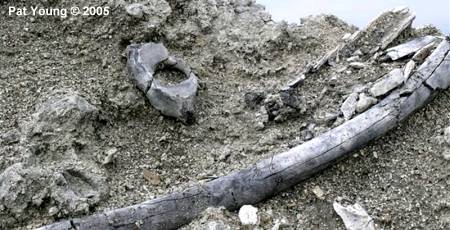
Sometimes even a fossil collector takes time to smell the roses, or in this case, the bones. A large block of limestone containing the remains of a long dead whale provides focus for a quiet and thoughtful moment to ponder the events that have led us all to this study of prehistoric events. Because of their large size, predation and other environmental factors, whale fossils are rarely found associated. This (ref. image) five-foot section of whale rib and atlas vertebra lie imbedded in a very large Pungo River limestone boulder (calcium carbonate provided the method for their preservation perhaps 10-million years ago).
And lastly, Diana Fattori (our Italian visitor) was asked to provide the title for this week's report, she translates it as "Always Easter in Aurora".
|
| March 19, 2005 |
|
Weekend 3: It takes more than heavy rain
Pat Young reports: Three days of pounding rain and high winds allowed 35 members of the Aurora Fossil Club, Ft. Fisher (NC) Aquarium and the remaining members of the Museum Friends to have high expectations for a prolific collecting experience. The rain had indeed washed last week's dust away and exposed many of the smaller Pungo teeth. Contortus, Hemipristis, carcharhinids and small hastalis were plentiful if one was lucky enough to find the right spots. Roberta Dann took advantage of the gully-washes to find a small posterior C. megalodon (2-3/8", ref image) while Keith Robertson searched the Pungo marl and came up with a blond C. chubutensis (2-1/2", ref image). Other Pungo chubbies were found by BJ Blake (3-1/2"), Jim White (2-1/4"), and Renee Long (1-1/2"). Soon after entering the mine, Louise Slate found a very nice Megachasma sp. tooth, the first of the season. Becky Hyne found yet another complete Echinorhinus tooth and two damaged ones. Andy Slate recovered a good Squatina tooth. Notorynchus lowers were found by Renee Long, BJ Blake (2) and Kim Greene with uppers being found by Becky and Dave Sanderson. Becky also found two teeth she identified as Isurus retroflexus and a small pathologic sand tiger tooth. C. hastalis in the 1-1/2" range and a few G. cuvier were found by various collectors.
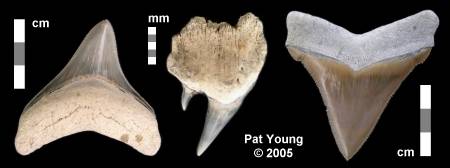
Ray/skate dermal scutes were found by Becky (3), Duane Hubbard (a nice double) and myself. Other finds included: Paul Murdoch's Squalodon tooth , BJ's two sperm whale teeth, fossil resin and a partial wahoo jaw (with one complete tooth), Dee Thonnard's dolphin teeth, Kim Greene's partial Hexanchus lower, Sharron Edwards' Hex upper (3/4", ref image), Jim White's shark rostral node, Renee Long's seal humerus and George Oliver's shark preorbital process.
After the hunt, we met for a dinner of BBQ and fried chicken, hosted by the Aurora Fossil Club.
Personally, I find the reading of Pat's report disconcerting. The James City 'blanket' that has accumulated on the tailings is not responding to heavy rains and the underlying sediments are not only failing to yield many shark teeth but even new invertebrates are not appearing. In addition, reportable finds are mainly being attributed to the most experienced collectors. For decent collecting, it would appear that an expanded collecting area be available to visitors.
|
| March 17, 2005 |
|
Invertophobia
Putting up the news each week is sometimes a frenzied affair, and occasionally it takes a day or two for it to fully register (probably like pain -- it's an age thing). On Wednesday, this week's editing finally registered -- a whale barnacle? Pat, our on-site reporter, is a blatant invertophile. When collecting 'slows down', she has the uncanny ability of seeing gems in mounds of "leaveirites". I knew barnacles were crustaceans and that there was a 'pretty' quality to some of their fossil remains, but otherwise, a barnacle was a barnacle (one aesthetic and evolutionary step up from an ostracod). Having allowed her observation to enter elasmo's 'news' space, I felt compelled to learn more about this Coronula diadema specimen.
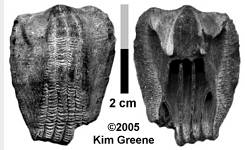 First, what are they? The current consensus classifies them as: Class: Crustacea; Subclass: Cirripedia; Order: Thoracica; Family: Balanidae; Genus Coronula Lamarck, 1802. Kim Greene then sent me an image of the specimen (accompanying) which should properly be referred to as a 'compartmental plate' (the Coronula body is enclosed by six of them), see: Treatise on Invertebrate Paleontology (Vol R(1), 1969; p289) which provides detailed information. This species is associated with cetaceans and has been reported worldwide from the Upper Miocene to recent. The San Diego Museum and Takahashi have some good images of complete Coronula specimens and/or compartments. So, I guess we vertebrate-centric types should be more open-minded, particularly when faced with acres of James City tailings. First, what are they? The current consensus classifies them as: Class: Crustacea; Subclass: Cirripedia; Order: Thoracica; Family: Balanidae; Genus Coronula Lamarck, 1802. Kim Greene then sent me an image of the specimen (accompanying) which should properly be referred to as a 'compartmental plate' (the Coronula body is enclosed by six of them), see: Treatise on Invertebrate Paleontology (Vol R(1), 1969; p289) which provides detailed information. This species is associated with cetaceans and has been reported worldwide from the Upper Miocene to recent. The San Diego Museum and Takahashi have some good images of complete Coronula specimens and/or compartments. So, I guess we vertebrate-centric types should be more open-minded, particularly when faced with acres of James City tailings.
|
| March 12 & 13, 2005 |
|
Weekend 2: Already getting tough
Pat Young reports: On Saturday, thirty-seven Museum Friends braved gale force winds and 38-degree temperatures to test their collecting skills. News of the previous week's sand dollar and great white finds had most hyped up. Others prayed they would be among the few lucky enough to find an elusive patch of Yorktown. After a quick scan of the small collecting area, most collectors staked a claim and brought out the digging tools or honed their Pungo crawl technique.
The largest and prettiest C. megalodon I saw was collected by Danny Gitler. His baby-blue iridescent trophy measured 3-1/4 inches. Others were found by Sharron Edwards and Eddie Horlick (2-7/8"), Dan Peters (lower 2-3/4 & 3" chubutensis). Chubutensis teeth were also found by Eric Sadorf (2"), John Miller (1-3/4") and Gregg Walden (1"). Cosmopolitodus teeth were best represented by Brian Hempy's 2" upper lateral, Keith Robertson's 2" lower, Ditchweezil's 1-7/8" lower and Dan Peters 1-3/4" upper & lower teeth. Carcharodon carcharias upper teeth were found by Gregg Walden (1-1/2") and Paul Murdoch (3/4"). Notorynchus teeth, both uppers and lowers were collected by Becky Hyne, Dave Sanderson, Candace Holliday, Michael Dunn and others. Michael also found the only pathologic tooth of the day, an upper Hemipristis. One Carcharoides catticus lateral was collected by Keith Robertson and John Everette found a nice Echinorhinus specimen.
Mammal material (now becoming scarce, except for whale vertebrae) included one 3-inch sperm whale tooth (Keith Robertson), two associated Squalodon molars with bone section (Paul Murdoch), Squalodon upper and lower (Becky), and upper horse tooth (Greg Faircloth). Kim Greene found the only complete bird bone, an unidentified coracoid. Sharron Edwards found three associated Yorktown shark vertebrae (1-3/4" x 3/4", ref. image) and Gregg Walden found four smaller Pungo ones. Invert material was best represented by Kim Greene's (rare for Lee Creek) partial Coronula diadema - a barnacle commonly found on whales.

Sunday's compliment of 35 Friends gathered under sunny skies, hoping the high winds from the day before had uncovered new fossils. We're a tenacious group and each of us settled into a routine; some browsing, some raking and even some wishing we had put more study into inverts.
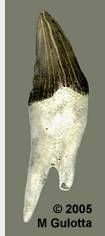 Shark finds were minimal. The largest complete C. megalodon was a Rita McDaniel's 2-3/4-incher. Anne Lineberry followed with two (1-3/4") chubutensis teeth. George Oliver rooted the weeds for a nice white one that measured 1-1/4 inches. Cosmopolitodus hastalis (broad-form) were found by David Wooten (2-3/8"), Ted Kordela (2") and John Everette (1-7/8"). Narrow-form hastalis were represented by Ted Kordela & Marco Gullota, Jr. (2"), and Marlyn Allen & Reggie Titmas (1-3/4"). Becky Hyne and David Griffith each found Carcharoides catticus teeth. Notorynchus teeth were found by Reggie Titmas (3 lowers, 1 upper), Jim Savia, David Wooten, Marco Gullota, Jr.(lowers). An outstanding Squalodon pre-molar was recovered by Melvin Gulotta (2-1/8", ref image). Other whale teeth in the <3-inch range were found by Bob Belcher, Becky Hyne (3) and Jim White. Richard Habron found a large denticle (?prickly shark). Xan Dubrock managed to collect three associated dolphin/porpoise vertebrae. A few other shark teeth were found, but in general, teeth in good condition are scarce.
Shark finds were minimal. The largest complete C. megalodon was a Rita McDaniel's 2-3/4-incher. Anne Lineberry followed with two (1-3/4") chubutensis teeth. George Oliver rooted the weeds for a nice white one that measured 1-1/4 inches. Cosmopolitodus hastalis (broad-form) were found by David Wooten (2-3/8"), Ted Kordela (2") and John Everette (1-7/8"). Narrow-form hastalis were represented by Ted Kordela & Marco Gullota, Jr. (2"), and Marlyn Allen & Reggie Titmas (1-3/4"). Becky Hyne and David Griffith each found Carcharoides catticus teeth. Notorynchus teeth were found by Reggie Titmas (3 lowers, 1 upper), Jim Savia, David Wooten, Marco Gullota, Jr.(lowers). An outstanding Squalodon pre-molar was recovered by Melvin Gulotta (2-1/8", ref image). Other whale teeth in the <3-inch range were found by Bob Belcher, Becky Hyne (3) and Jim White. Richard Habron found a large denticle (?prickly shark). Xan Dubrock managed to collect three associated dolphin/porpoise vertebrae. A few other shark teeth were found, but in general, teeth in good condition are scarce.
One Mellita sp. sand dollar (Eric Sadorf) and one Arbacia (Judy Stiles) were found. Other invert finds require diligent searching for pristine examples as much of the area is re-worked lower James City. Becky Hyne's efforts yielded a nice Mud crab (Menippe sp) propodus (left, ref. image) with cheliped dactylus (moveable finger) attached. It is apparent that the Lee Creek collector's best friend this season is going to be lots of rain and hopefully, that PCS will allow an extension of the collecting area.
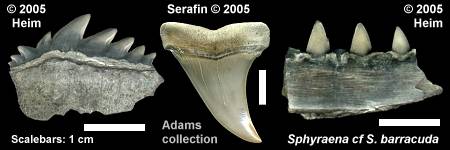
Conditions weren't good for digital images, so we're also including a couple images from last weekend including Heim's patho Notorynchus, Montine's barracuda and John Adams' nicely curved hastalis lateral.
|
| March 5 & 6, 2005 |
|
Weekend 1: Season Opener
Hundreds anticipate their first visit to PCS each season, and "Friends" are comforted with the knowledge they will be amongst the first. Forty-five of them gathered with great anticipation Saturday morning, and despite the cool conditions, endured the waiting for two busloads of collectors to assemble. Gazing into the pit, the new "North End" (of the NCPC block) looked promising. For safety reasons (high water conditions), the originally planned collecting area had been significantly reduced -- still, the hills looked promising.

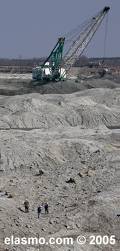 Collectors dispersed quickly to sample these new hills. Those familiar with the mine's tailings were first to notice that the Pungo and Yorktown sediments were largely blanketed by a crust of James City shells and corals. It took time to catch on that the typical index fossils, which guide one's collecting efforts to specific areas, no longer, applied -- James City material was everywhere.
Collectors dispersed quickly to sample these new hills. Those familiar with the mine's tailings were first to notice that the Pungo and Yorktown sediments were largely blanketed by a crust of James City shells and corals. It took time to catch on that the typical index fossils, which guide one's collecting efforts to specific areas, no longer, applied -- James City material was everywhere.
Collectors are not only obsessed, but adaptable, and these new hills, cloaked in invertebrates, were soon mastered by the more experienced. Shark tooth collectors traditionally collect around or pass quickly through the James City; these are sediments for those Aurora 1%'ers -- those sometimes violent and obviously deviant shell collectors.

When sharp eyes are brought to bear on the James City, normally unusual fossils appear in relative abundance. This became a feature of the weekend, and might continue into the season. In the two days, six sand dollars (Mellita cf M. aclinensis, ref. Rich Olsen's 2-1/2 x 2-5/8" specimen) and six sea urchins, (Arbacia imperocera), would be gathered. In addition, Gregg Walden found a neat Psammechinus philanthropus (ref image).
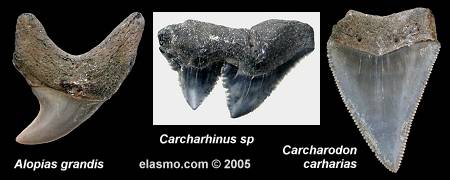
Despite the James City learning curve, Saturday's collectors did quite well. About two dozen Carcharocles were reported, the larger specimens included John Adams' 4-1/16" meg, Tom Caggiano's c 4-inch meg, Gary Thorne's 3-7/8" meg (plus 5 others) and John Timmerman's 3-3/4" lower meg (plus 3 more). Cosmopolitodus hastalis teeth were abundant (maybe a hundred or so) with top honors going to Fred Mazza for his large & beautiful 2-3/4" specimen. Carcharodon carcharias teeth were found by David Bunn (1-5/8" Yorktown) and John Adams (1-1/4"). At least a dozen Notorynchus lowers were seen, and Kim Greene found the only complete Hexanchus of the weekend. The 'usual' suspects were recovered in abundance. The best of the two Echinorhinus teeth was Ed Swiatovy's beautiful brown-crowned specimen. Most unusual of the day was Gregg Walden's 3/4-inch Alopias grandis (ref image), but two pathologics were in contention, Bill Heim's Notorynchus and Louise Holland's Carcharhinus (one root two crowns, 1.2 x 2.0 cm, ref image).
The day also saw a number of Squalodon (Keith Robertson & Jim Bourdon) and sperm whale teeth (Fred Mazza & Keith Robertson), BJ Blake's ?porpoise partial periotic with stapes, a Mola upper premaxillary (Mike McCloskey), marlin predentary (Mike Folmer), fossil resin (George Klein) and David Bunn's Trigonostoma sp (ref image) shell in superb condition. All in all, Saturday kicked-off the season in smart fashion.
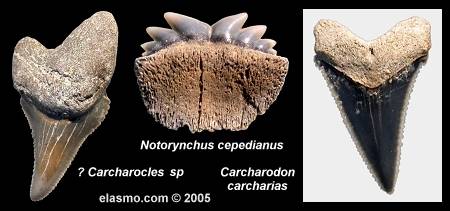
 Saturday's overcast and threatening skies gave way to a sunny but breezy Sunday for forty-five more collectors. As might be expected, the small area could not live-up to Saturday's results. Mary Lightfoot's megalodon upper (3-5/8") was the largest of eight reported Carcharocles specimens. Most interesting was a small (1-inch) Carcharocles tooth from an undetermined file position found by Becky Hyne (ref image). Hastalis teeth were smaller but still abundant; top examples were recovered by Ira Guy (2-1/2") and Gary Grimsley (2-3/8"). Ira Guy also had a Carcharodon carcharias juvie -- a 3/4-inch upper anterior bearing a cusplet (ref image). A dozen more Notorynchus were found including Uwe Heine's symphyseal (ref image). Otherwise, the usual 'common' teeth were reported in abundance. Additional finds included a complete Squalodon premolar (Gail Leget), pearls (Cindi Muston & Carl Campbell), nine ray dermal scutes and a 14-inch fragment of 2-inch wide whale rib with Carcharocles bite and cut marks (Howie Cohn). Aesthetics can often play a part in fossil collecting, and Sharron Edwards' specimen of a tube worm embraced coral (ref image) is an extraordinary example.
Saturday's overcast and threatening skies gave way to a sunny but breezy Sunday for forty-five more collectors. As might be expected, the small area could not live-up to Saturday's results. Mary Lightfoot's megalodon upper (3-5/8") was the largest of eight reported Carcharocles specimens. Most interesting was a small (1-inch) Carcharocles tooth from an undetermined file position found by Becky Hyne (ref image). Hastalis teeth were smaller but still abundant; top examples were recovered by Ira Guy (2-1/2") and Gary Grimsley (2-3/8"). Ira Guy also had a Carcharodon carcharias juvie -- a 3/4-inch upper anterior bearing a cusplet (ref image). A dozen more Notorynchus were found including Uwe Heine's symphyseal (ref image). Otherwise, the usual 'common' teeth were reported in abundance. Additional finds included a complete Squalodon premolar (Gail Leget), pearls (Cindi Muston & Carl Campbell), nine ray dermal scutes and a 14-inch fragment of 2-inch wide whale rib with Carcharocles bite and cut marks (Howie Cohn). Aesthetics can often play a part in fossil collecting, and Sharron Edwards' specimen of a tube worm embraced coral (ref image) is an extraordinary example.
PCS has been kind enough to provide access to these tailings, and there is a great potential for what they might yield in up-coming months. Most collectors were very pleased with their 'take' this weekend, but disconcerted by the James City 'umbrella' that 'shielded' them. I was impressed by the 'report-worthy' material that was recovered in what originally appeared to be James City dunes. My personal perspective would be that until the collecting area is enlarged, rain will be an ongoing prerequisite for a productive (shark tooth-centric) visit.
|
| February 15, 2005 |
|
Slots Awarded
Slots for the Spring 2005 season have been allocated and details are being sent to the relevant parties. The season will start with the Friends on March 5th (thru the 19th) and continue to May 30th (Fossil Fair Invitational). Word has it we'll still be in the same NCPC Tract, but further north than last fall.
 It might be suggested that collectors show-up closer to 7:30 than 8:00 am. The extra paperwork now required could delay entry if everyone arrives at 8:00 or later. Pat wanted me to remind the clubs that if they are unable to fill all their slots, they should contact Public Affairs so others have the opportunity to use them.
It might be suggested that collectors show-up closer to 7:30 than 8:00 am. The extra paperwork now required could delay entry if everyone arrives at 8:00 or later. Pat wanted me to remind the clubs that if they are unable to fill all their slots, they should contact Public Affairs so others have the opportunity to use them.
Pat and I put together a new slideshow for this spring. Not very sharky, but still a part of the Lee Creek experience.
|
| January 13, 2005 |
|
Spring Season Announced
The PCS Public Affairs Dept. has announced the details for Spring 2005 access.
The Season will begin the first weekend in March. As usual, the first 4-5 collecting days go to Friends of the Museum members.
Curtis Ormond, Sr. will begin accepting email requests from collectors this coming Monday morning (Jan 17th) at 8:00 am and will continue until January 31st. No emails submitted before 8:00 am will be considered. If a club has already sent in a request, they must re-submit them within these dates and times. Season slots should be announced to the various clubs by the middle of February.
For now, there are no new rules for this season, but as a reminder:
Photo ID required.
Steel-toed footwear required.
Hard hat must be worn at all times when in the mine.
No sleeveless shirts or tank-tops.
|
|
|